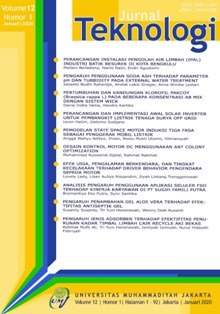PENGARUH JENIS ADSORBEN TERHADAP EFEKTIFITAS PENURUNAN KADAR TIMBAL LIMBAH CAIR RECYCLE AKI BEKAS
Main Article Content
Abstract
Downloads
Article Details
COPYRIGHT POLICY
The author(s) of an article published in the Jurnal Teknologi retains ownership of the intellectual property rights in work (s).
PUBLISHING RIGHTS
The author(s) of an article published in the Jurnal Teknologi have unrestricted publication rights. The authors give the Jurnal Teknologi the right to publish the article and designate the Faculty of Engineering Universitas Muhammadiyah Jakarta Publishing as the original publisher of the article.
LICENSING POLICY
Journal of Mechanical Engineering and Sciences is an open-access journal that follows the Creative Commons Non-Commercial 4.0 International License (CC BY-NC 4.0), which states that:

Under this license, the reusers must give appropriate credit, provide a link to the license, and indicate if changes were made. Users may do so in any reasonable manner, but not in any way that suggests the licensor endorses users or their use.
Please take the time to read the whole license agreement (https://creativecommons.org/licenses/by-nc/4.0/). As long as reusers follow the license conditions, the owner cannot withdraw these freedoms. The following components are included under this license:
 Attribution: Users must provide appropriate attribution, including a link to the license, and indicate whether or not they made any modifications. Users are free to do so reasonably, but not in a manner that indicates the licensee approves of their usage.
Attribution: Users must provide appropriate attribution, including a link to the license, and indicate whether or not they made any modifications. Users are free to do so reasonably, but not in a manner that indicates the licensee approves of their usage.
 NonCommercial: Users may not use the material for commercial purposes.
NonCommercial: Users may not use the material for commercial purposes.
References
Azamia, M. (2012). Chemical Laboratory Liquid Waste Processing in Decreasing Organic Levels and Heavy Metals Fe, Mn, Cr With the Method of Coagulation and Adsorption. (bachelor research paper) FMIPA- UI. Jakarta.
Fajarwati, I. (2015). Groundwater Treatment With a Multifiltration System Using Shells, Zeolites, and Activated Carbon. Student Journal of Environmental Engineering Bachelor degree: Vol. 1, No. 1. UNTAN. Pontianak.
Kristiana I, Joll C, Heitz A. (2011). Powdered activated carbon coupled with enhanced coagulation for natural organic matter removal and disinfection by-product control: Application in a Western Australian water treatment plant. Chemosphere, 83:661-7.
Hendra, R. (2008). Manufacture of Activated Carbon Made from Indonesian Coal with Physics Activation Methods and Characteristics. (research paper Department of Mechanical Engineering). University of Indonesia.
Khimayah. (2015). Variations in Zeolite Diameter to Reduce Iron (Fe) Levels in Well Dig Water. Skripsi. Universitas Diponegoro. Semarang.
Larasati, I.A.; Susanawati, D.L.; dan Suharto, B. (2014). Effectiveness of Heavy Metal Adsorption on Leachate Water Using Activated Carbon, Zeolite, and Silica Gel in TPA Tlekung, Batu. Journal of Natural Resources and Environment. Malang.
Mulyati, S. (2006). Potential of Local Coal with Treatment as Adsorbent for Handling Liquid Benzene and Toluene Waste. Research Paper. Department of Gas and Petrochemical Engineering. Universitas Indonesia. Depok.
Setiaka, J; Ulfin, I; dan Widiastuti, N. (2010). Metal Ion Adsorption Cu (II) In Solution at Coal Base Ash Using Column Method. Makalah. Jurusan Kimia FMIPA. ITS. Surabaya.

